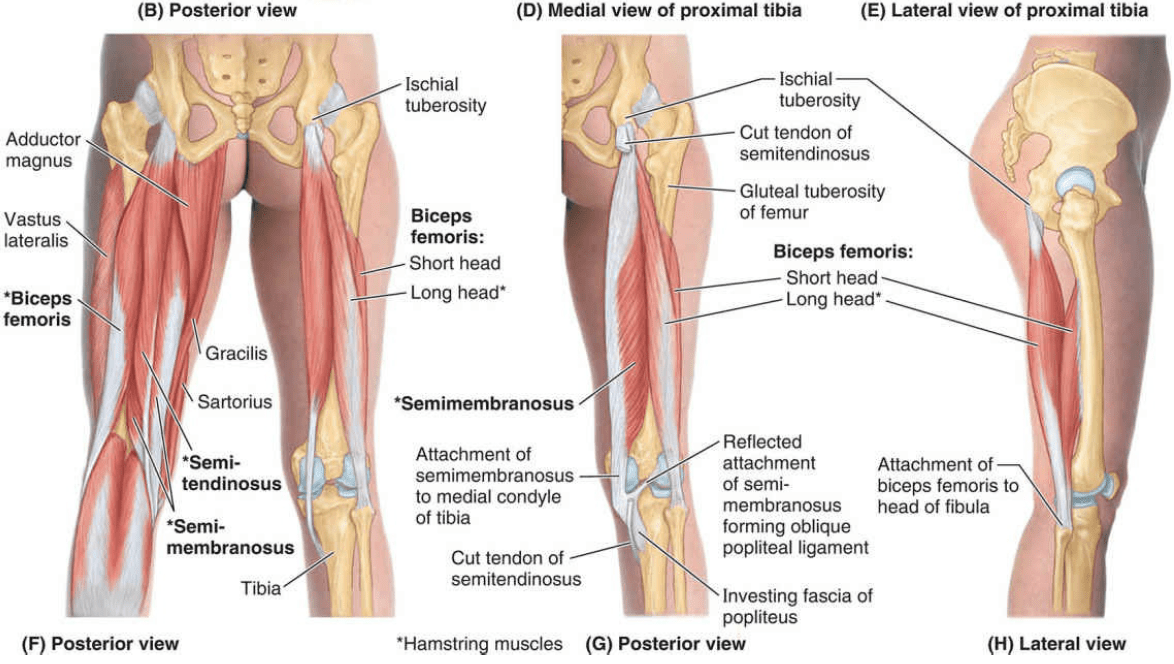Hamstring Injuries
content of this page
1- Introduction
2- Anatomical Overview
3- Causes
4- Treatment
Introduction
Hamstring strains (pulled and/or torn hamstrings) are common in individuals who run and/or kick hard (e.g., in running, jumping, and quick-start sports such baseball, basketball, football, and soccer). The violent muscular exertion required to excel in these sports may avulse (tear) part of the proximal tendinous attachments of the hamstrings to the ischial tuberosity. Hamstring strains are twice as common as quadriceps strains.

Anatomical Overview
The hamstrings are a group of three muscles located on the back of the thigh: the biceps femoris, semitendinosus, and semimembranosus. These muscles originate from the ischial tuberosity, a bony prominence at the base of the pelvis, and extend down the back of the thigh, crossing both the hip and knee joints.
The primary function of the hamstrings is to flex the knee and extend the hip, making them crucial for activities such as running, jumping, and kicking. Hamstring injuries typically occur during activities that involve rapid acceleration or deceleration, such as sprinting, or when the muscles are stretched beyond their limits, leading to tears in the muscle fibers.
Hamstring injuries are classified based on their severity. Grade 1 injuries involve mild strains with minimal tearing of muscle fibers, leading to mild discomfort and minimal loss of function. Grade 2 injuries are moderate strains with partial tearing of muscle fibers, causing more significant pain, swelling, and loss of function. Grade 3 injuries are severe strains with complete tearing of the muscle or tendon, resulting in intense pain, significant swelling, and inability to bear weight.

Causes
Muscle Imbalance: Weakness or imbalance between the quadriceps muscles at the front of the thigh and the hamstring muscles at the back of the thigh can increase the risk of hamstring injuries. This imbalance can result from inadequate strength training or overemphasis on certain muscle groups.
Poor Flexibility: Tightness in the hamstring muscles or inadequate stretching can increase the risk of injury, as tight muscles are more prone to strain during physical activity.
Fatigue: Muscles that are fatigued are more susceptible to injury. Overuse or lack of rest between intense workouts can lead to muscle fatigue and increase the risk of hamstring injuries.
Sudden Movements: Activities that involve sudden acceleration or deceleration, such as sprinting, jumping, or kicking, can put excessive stress on the hamstring muscles and lead to injury.
Improper Warm-up: Failing to properly warm up before engaging in physical activity can increase the risk of muscle strain. A thorough warm-up helps increase blood flow to the muscles and prepares them for activity.
Previous Injury: A history of hamstring injuries can weaken the muscles and make them more susceptible to future injuries if proper rehabilitation and preventive measures are not taken.
Age and Muscle Elasticity: As people age, their muscles tend to lose elasticity and become more prone to injury. This is why hamstring injuries are more common among older individuals, particularly those who are still active in sports or physical activities.
Treatment
Rest: Avoid activities that cause pain or discomfort to allow the injured muscle to heal. Using crutches or a brace may be necessary to reduce weight-bearing on the affected leg.
Ice: Apply ice packs to the injured area for 15-20 minutes several times a day to reduce pain and swelling.
Compression: Use a compression bandage to help reduce swelling and provide support to the injured muscle.
Elevation: Elevate the leg to reduce swelling, especially when resting or sleeping.
Pain Management: Over-the-counter pain relievers such as ibuprofen or acetaminophen can help manage pain and reduce inflammation.
Physical Therapy: Once the acute pain and swelling have subsided, physical therapy exercises can help restore strength, flexibility, and function to the injured muscle. This may include stretching exercises, strengthening exercises, and functional exercises to improve muscle coordination and balance.